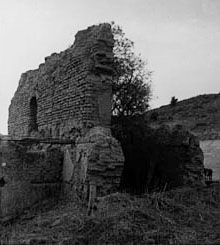Mexican Secularization Act of 1833
[2][3] Once fully implemented, the secularization act took away much of the California Mission land and sold it or gave it away in large grants called ranchos.
[5] The Spanish missions in Alta California were a series of 21 religious and military outposts; established by Catholic priests of the Franciscan order between 1769 and 1823[6] for the purpose of spreading Christianity among the local Native Americans.
The settlers introduced European fruits, vegetables, cattle, horses, ranching and technology into the Alta California region and to the Mission Indians.
[7] All Indians within the military districts of San Diego, Santa Barbara, and Monterey who were found qualified were freed from missionary rule and made eligible to become Mexican citizens.
[8][9] By 1830 even those new to California appeared confident in their own abilities to operate the mission ranches and farms independently; the padres, however, doubted the capabilities of their charges in this regard.
[10] New immigration, of both Mexican and foreign origins, increased pressure on the Alta California government to seize the Church-controlled mission properties and dispossess the natives in accordance with Echeandía's directive.
Governor Figueroa issued a regulation (Reglamento Provisional para la secularizacion de las Misiones) on August 9, 1834, outlining the requirements for the distribution of property (land, cattle, and equipment) to each mission's neophytes.
To each head of a family and to all over 20 years old, will be given from the Mission lands a lot not over 400 nor less than 100 varas square" (28 to 7 acres), plus "6....pro rata...one-half of the livestock" and "7.... half or less of the existing chattels, tools, and seed".
[17] This meant that the missions would hold title only to the worship chapel, the residences of the priests, and a small amount of land surrounding the church for use as gardens.
[21] In 1838, Mission San Juan Capistrano property was auctioned off under questionable circumstances for $710 worth of tallow and hides, (equivalent to $15,000 in 2004 U.S. dollars) to Englishman John (Don Juan) Forster (Governor Pío Pico's brother-in-law, whose family would take up residence in the friars' quarters for the next 20 years) and his partner James McKinley.
[23] The first secular priest to take charge of the Mission, Reverend José Maria Rosáles, arrived on October 8, 1843;[24] Father Vicente Pascual Oliva, the last resident missionary, died on January 2, 1848.
On June 8, 1846, Mission San Diego de Alcalá was given to Santiago Argüello by Governor Pío Pico "...for services rendered to the government.
Most of the grants were made to rich "Californios" of Spanish background who had long been casting envious eyes on the vast holdings of the Roman Catholic missions.
The grant was originally called Rancho Santa Monica and encompassed present-day El Cajon, Bostonia, Santee, Lakeside, Flinn Springs, and the eastern part of La Mesa.
Maria Estudillo was the wife of Don Miguel Pedrorena (1808–1850), a native of Madrid, Spain, who had come to California from Peru in 1838 to operate a trading business.
[32] Mission San Gabriel Arcángel was sold to American settlers, and the funds were used to pay off Governor Pico's debt.
But on Christmas Day 1899, the San Jacinto Earthquake shook the Pala Valley, causing the roof over the church sanctuary to collapse.
[49] In 1902, a group named the "Landmarks Club of Southern California", under the direction of American journalist, historian, and photographer Charles Fletcher Lummis, purchased Pala Mission.
The following year, the Club returned ownership to the Catholic Church and "saved the Chapel and a few rooms from complete ruin with a timely work of partial restoration.
[51] Diego Sepúlveda Adobe, sold to Rancho Santiago de Santa Ana, is now a local history museum, operated by the Costa Mesa Historical Society.
Alvarado's actions began a period of de facto home rule, in which the weak and fractious central government was forced to allow more autonomy in its most distant department.
The acts broke the large landholding of the missions and paved the way for attracting more settlers to California by making land grants easier to obtain.
Without the control enforced by the Franciscan friars and the troops preventing them from leaving, the Mission Indians soon abandoned the fields (even if granted) and joined other interior tribes, or sought work on the new ranchos and expanding pueblos.
Although the original intent of the secularization legislation was to have the property divided among former surviving Mission Indians, most of the grants were made to local Californios (See: List of Ranchos of California).
On July 7, 1846, US forces took possession of Monterey, the capital of California, and terminated the authority and jurisdiction of Mexican officials that day.
In order to investigate and confirm titles in California, American officials acquired the provincial records of the Spanish and Mexican governments in Monterey.
Aside from indefinite survey lines, the Land Commission had to determine whether the grantees had fulfilled the requirements of the Mexican colonization laws.
[64] The confirmation process required lawyers, translators, and surveyors, and took an average of 17 years (with American Civil War, 1861–1865) to resolve.
Beginning with Rancho Suscol in 1863, special acts of Congress were passed that allowed certain claimants to preempt their land without regard to acreage.
The mission is currently surrounded by the Fort Hunter Liggett Military Reservation, which was acquired by the U.S. Army from the Hearst family during World War II to train troops.









